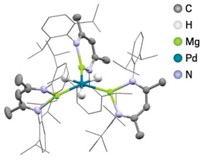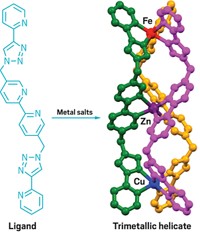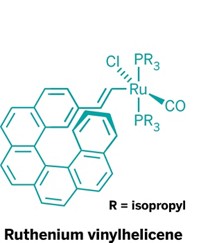Advertisement
Grab your lab coat. Let's get started
Welcome!
Welcome!
Create an account below to get 6 C&EN articles per month, receive newsletters and more - all free.
It seems this is your first time logging in online. Please enter the following information to continue.
As an ACS member you automatically get access to this site. All we need is few more details to create your reading experience.
Not you? Sign in with a different account.
Not you? Sign in with a different account.
ERROR 1
ERROR 1
ERROR 2
ERROR 2
ERROR 2
ERROR 2
ERROR 2
Password and Confirm password must match.
If you have an ACS member number, please enter it here so we can link this account to your membership. (optional)
ERROR 2
ACS values your privacy. By submitting your information, you are gaining access to C&EN and subscribing to our weekly newsletter. We use the information you provide to make your reading experience better, and we will never sell your data to third party members.
Synthesis
Supramolecular transformer morphs into different shapes
An iron-containing complex can switch from a tetrahedron to a helix to a prism
by Melissae Fellet, special to C&EN
August 15, 2018

In metal-containing supramolecular complexes, organic ligands self-assemble around metal atoms to form molecular cages of various sizes and shapes. Researchers can change a complex’s shape by changing either the metal or the ligand, but they are still learning how to produce a desired shape by design. Now, researchers have created a supramolecular complex that converts between three different shapes—a tetrahedron, helix, and prism—with the help of various chemical stimuli (J. Am. Chem. Soc. 2018, DOI: 10.1021/jacs.8b05082).
“Switching between the structures allows us to make use of all their properties on demand,” says Derrick A. Roberts, who worked on the project as a graduate student at the University of Cambridge and is now at the Karolinska Institute. Prismlike supramolecular complexes can punch holes in cell membranes and mimic artificial ion channels. Helical complexes can interact with DNA, and tetrahedral cages can trap reactive chemicals. “This complex is like a Swiss Army knife,” he says.
The Cambridge researchers, led by Jonathan R. Nitschke, first combined iron atoms and nitrogen-containing ligands to form a tetrahedral complex. Then they added cyclooctyne, which snapped onto a reactive portion in the center of each ligand. This modification slightly bent each ligand, enabling the complex to change its structure. Most of this modified tetrahedron morphed into a helical structure, observed with nuclear magnetic resonance (NMR) spectroscopy.
To coax the complex back to a tetrahedral structure, the researchers strengthened the bonds between the ligands and the metal atoms at the corners of the tetrahedron. They replaced the electron-withdrawing 4-fluoroaniline caps on the ends of the ligands with electron-rich 4-methoxyaniline, enhancing the links with iron atoms. The researchers watched the complex switch between the helical and tetrahedral shapes using NMR.
Finally, the researchers wondered if they could change the complex’s structure again using a strategy known to guide supramolecular assembly: anion templating. They added a salt containing PF6 anions to the complex and characterized the resulting prism structure using X-ray crystallography.
It’s the first time that anyone has transformed the structure of a supramolecular complex three different ways, says Xiaopeng Li of the University of South Florida.
James D. Crowley, a chemist at the University of Otago, wonders if these types of structures could overcome a problem observed with confinement catalysts. These cagelike structures facilitate reactions by trapping molecules in closed spaces, but they often clog with product and stall at the end of a reaction, he says. In this case, chemists could catalyze a reaction within the tetrahedron and then trigger a structural change to form a helical complex, forcing out the product.





Join the conversation
Contact the reporter
Submit a Letter to the Editor for publication
Engage with us on Twitter